Papers by shemelis tesema
International Journal of Agricultural Research, Innovation and Technology, Aug 21, 2023

International Journal of Agricultural Research, Innovation and Technology, 2022
Depletion of soil fertility, depletion of macro- and micro-nutrients and soil organic matter and ... more Depletion of soil fertility, depletion of macro- and micro-nutrients and soil organic matter and inappropriate and imbalanced fertilizer application are among the most important factors that reduces the food barley production in Ethiopia. Therefore, the experiment was conducted to evaluate NPSB blended fertilizer rate effect on improving production of food barley in Semen Ari District, Southwestern Ethiopia during main cropping season. Control, (142 NPS + 159 Urea) kg ha-1, (150 NPSB + 41 Urea) kg ha-1, (200 NPSB + 72 Urea) kg ha-1, (250 NPSB + 102 Urea) kg ha-1 and (100 NPSB + 161 Urea) kg ha-1 treatments were used for the experiment which laid out in RCBD following three replication with spacing of 20 cm between rows; and HB 1307 improved food barley seeds were drilled on prepared rows. Full dose of blended and potassium fertilizers were applied at planting time and urea was applied in two split. The result revealed that food barley responded well to application of N, P, S and B t...
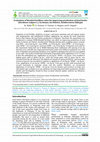
International Journal of Agricultural Research, Innovation and Technology, Jan 8, 2022
Depletion of soil fertility, depletion of macro-and micro-nutrients and soil organic matter and i... more Depletion of soil fertility, depletion of macro-and micro-nutrients and soil organic matter and inappropriate and imbalanced fertilizer application are among the most important factors that reduces the food barley production in Ethiopia. Therefore, the experiment was conducted to evaluate NPSB blended fertilizer rate effect on improving production of food barley in Semen Ari District, Southwestern Ethiopia during main cropping season. Control, (142 NPS + 159 Urea) kg ha-1 , (150 NPSB + 41 Urea) kg ha-1 , (200 NPSB + 72 Urea) kg ha-1 , (250 NPSB + 102 Urea) kg ha-1 and (100 NPSB + 161 Urea) kg ha-1 treatments were used for the experiment which laid out in RCBD following three replication with spacing of 20 cm between rows; and HB 1307 improved food barley seeds were drilled on prepared rows. Full dose of blended and potassium fertilizers were applied at planting time and urea was applied in two split. The result revealed that food barley responded well to application of N, P, S and B than the unfertilized one. Application of 100 kg ha-1 NPSB + 161 kg ha-1 Urea resulted in highest grain yield of 3806.3 kg ha-1 , while the lowest grain yield of 1939.2 kg ha-1 was recorded from the nil. Moreover, the highest net benefit of 32124.56 ETB ha-1 and economic returns of 942.2% was recorded in response to application of 100 kg ha-1 NPSB + 161 kg ha-1 Urea. Application of 100 kg ha-1 NPSB + 161 kg ha-1 Urea gave 49.05% yield increment and 40.24% increment in economic return over the control. Therefore, we recommend application of 100 kg ha-1 NPSB + 161 kg ha-1 Urea for farmers and investor's in study area and similar agro-ecologies as it was optimum for improving food barley production. Further studies and investigation should be done on plant nutrient uptake, nutrient use efficiency and over location.

Soil infertility constraints and low soil pH are the predominant problems to barley production an... more Soil infertility constraints and low soil pH are the predominant problems to barley production and productivity in the highland regions of Ethiopia. In reaction to this, the experiment was carried out in highland areas of Semen Ari district with low soil pH to determine the effects of split application of lime on soil pH and grain yield of barley from 2018 to 2020 for three cropping years. Six treatments were used for this experiment as control (no inputs); 200 kg ha-1 of NPKSZnB + 94 kg ha-1 of urea top-dressed; lime applied at once (7.6 t ha-1); two splits or 50% (1 st and 2 nd years); three splits or 33% (1 st , 2 nd and 3 rd years); two splits or 50% (1 st and 3 rd years). The RCBD design within three replications was employed to arrange treatments. The result of soil analysis after lime application revealed that it improved available phosphorus and raised the soil pH, but decreased the exchangeable acidity compared to control treatments. Among the treatments, lime application in two splits (1 st and 3 rd years) gave the maximum grain yield (3061.5 kg ha-1) of barley significantly, whereas the minimum yield was obtained from the control (untreated plot). The maximum grain yield in the third year was obtained from the application of two splits or 50% (1 st and 3 rd years) which were statistically non-significant with the application of three splits or 33% in each year (1 st , 2 nd and 3 rd years) and two splits or 50% (1 st and 2 nd years). Thus, to enhance soil fertility status and obtain better barley grain yield, farmers must undertake the use of a split application of lime with inorganic fertilizer rather than a sole application of inorganic fertilizer. It suggested that, depending on the accessibility of lime and affordability of barley producers, farmers in the study area could use the above application frequencies with recommended inorganic fertilizers (69N and 46P2O5). Further investigation should be done on plant nutrient uptake, nutrient use efficiency and optimization.
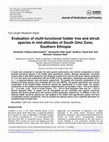
Journal of Horticulture and Forestry, 2020
A study was conducted to evaluate the early growth performance and nutrient composition of some s... more A study was conducted to evaluate the early growth performance and nutrient composition of some selected tree/shrub species in the fodder bank agroforestry system. Moringa stenopetala, Terminalia brownii, Morus alba, Melia azedarach, and Sesbania sesban were used for this study. Square quadrants of 16 m2 plot sizes were established with the RCBD of three replications. Seedlings were planted with 1 m × 1 m spacing between rows and plants respectively. The growth and chemical composition of the studied tree/shrub species were evaluated with one way ANOVA. The growth parameters and nutrient composition of the studied fodder tree/shrub species are significantly (P ≤ 0.05) varied. The nutrient composition of the studied tree/shrub species ranged between percentages of 88.3 - 90.6 of Dry Matter, 5.7 - 13 of Ash, 12.45 - 22.35 of Crude Protein, 11.8 – 23.5 of Acid Detergent Fiber and 18.1 - 33.6 of Neutral Detergent Fiber. S. sesban and M. stenopetala are the consistent and superior tree/s...
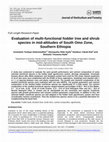
A study was conducted to evaluate the early growth performance and nutrient composition of some s... more A study was conducted to evaluate the early growth performance and nutrient composition of some selected tree/shrub species in the fodder bank agroforestry system. Moringa stenopetala, Terminalia brownii, Morus alba, Melia azedarach, and Sesbania sesban were used for this study. Square quadrants of 16 m 2 plot sizes were established with the RCBD of three replications. Seedlings were planted with 1 m × 1 m spacing between rows and plants respectively. The growth and chemical composition of the studied tree/shrub species were evaluated with one way ANOVA. The growth parameters and nutrient composition of the studied fodder tree/shrub species are significantly (P ≤ 0.05) varied. The nutrient composition of the studied tree/shrub species ranged between percentages of 88.3-90.6 of Dry Matter, 5.7-13 of Ash, 12.45-22.35 of Crude Protein, 11.8-23.5 of Acid Detergent Fiber and 18.1-33.6 of Neutral Detergent Fiber. S. sesban and M. stenopetala are the consistent and superior tree/shrub species with growth performance and nutrient content parameters respectively. In addition to this, the selected fodder tree/shrub species are well adapted in the fodder bank agroforestry system and have considerable nutrient constituents. Thus the studied tree species seems to be a potential alternative for complementing the basal feed.

International Journal of Agricultural Research, Innovation and Technology, Jan 24, 2023
Soil fertility depletion is a serious problem in Ethiopian highland due to leaching of topsoil by... more Soil fertility depletion is a serious problem in Ethiopian highland due to leaching of topsoil by runoff, which reduces production and productivity. This experiment conducted in Debub Ari district for two years with the aim of investigating single and combined effect of compost and FYM with inorganic fertilizer on soil fertility improvement and onion crop production. The treatment includes T1) Control, T2) Recommended NP (69/30), T3) NPSZnB (120N, 92P2O5, 20.06S, 5.89Zn, 0.66B) kg ha-1 (264 kg NPSZnB + 161 kg urea), T4) 10 t ha-1 FYM, T5) 10 t ha-1 compost, T6) 5 tha-1 FYM + 50% of treatment-3 and T7) 5 t ha-1 compost + 50% of treatment-3. Treatments are arranged in randomized complete block design with three replications. Soil before the experiment showed moderately acidic, moderate in organic matter and boron, low in sulfur high in available P and total nitrogen. The results showed significant differences among the treatments on onion plant height, bulb diameter, marketable and biological yield. The highest total yield 19.99 t ha-1 , 19.59 t ha-1 and 19.25 t ha-1 was recorded from NPSZnB (120N, 92P2O5, 20.06S, 5.89Zn, 0.66B) kg ha-1 , 5 t ha-1 compost + 50% of T-3 and 5 t ha-1 FYM + 50% of T-3 respectively and that increase yield by 39%, 35% and 33% over the control. Soils after the experiment become medium in sulfur remain static in available boron and total nitrogen. Economic feasibility that the maximum net benefit of 246059 and 242442 ETB ha-1 with acceptable %MRR of 290 and 1300 was obtained with the application of NPSZnB (120N, 92P2O5, 20.06S, 5.89Zn, 0.66B) kg ha-1 and 5 t ha-1 FYM + 50% of T-3, respectively. Therefore, the application of those two treatments is recommended for higher yield production in the study area.

International Journal of Agricultural Research, Innovation and Technology, Jan 24, 2023
Soil fertility depletion is a serious problem in Ethiopian highland due to leaching of topsoil by... more Soil fertility depletion is a serious problem in Ethiopian highland due to leaching of topsoil by runoff, which reduces production and productivity. This experiment conducted in Debub Ari district for two years with the aim of investigating single and combined effect of compost and FYM with inorganic fertilizer on soil fertility improvement and onion crop production. The treatment includes T1) Control, T2) Recommended NP (69/30), T3) NPSZnB (120N, 92P2O5, 20.06S, 5.89Zn, 0.66B) kg ha-1 (264 kg NPSZnB + 161 kg urea), T4) 10 t ha-1 FYM, T5) 10 t ha-1 compost, T6) 5 tha-1 FYM + 50% of treatment-3 and T7) 5 t ha-1 compost + 50% of treatment-3. Treatments are arranged in randomized complete block design with three replications. Soil before the experiment showed moderately acidic, moderate in organic matter and boron, low in sulfur high in available P and total nitrogen. The results showed significant differences among the treatments on onion plant height, bulb diameter, marketable and biological yield. The highest total yield 19.99 t ha-1 , 19.59 t ha-1 and 19.25 t ha-1 was recorded from NPSZnB (120N, 92P2O5, 20.06S, 5.89Zn, 0.66B) kg ha-1 , 5 t ha-1 compost + 50% of T-3 and 5 t ha-1 FYM + 50% of T-3 respectively and that increase yield by 39%, 35% and 33% over the control. Soils after the experiment become medium in sulfur remain static in available boron and total nitrogen. Economic feasibility that the maximum net benefit of 246059 and 242442 ETB ha-1 with acceptable %MRR of 290 and 1300 was obtained with the application of NPSZnB (120N, 92P2O5, 20.06S, 5.89Zn, 0.66B) kg ha-1 and 5 t ha-1 FYM + 50% of T-3, respectively. Therefore, the application of those two treatments is recommended for higher yield production in the study area.
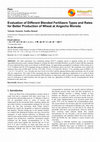
Plant, 2019
The field experiment was conducting during 2016/17 cropping season at angecha testing site of Are... more The field experiment was conducting during 2016/17 cropping season at angecha testing site of Areka Agricultural Research center, southern Ethiopia to evaluate the effect of blended fertilizer on yield of wheat with the treatments of seven replicated three times across farmers in RCBD design. An approximate geographical coordinates of the testing site is 7o 0' N latitude and 38o 29'E longitude having an altitude of 2381meteres above sea level. The treatments were control (no fertilizer), three rates of NPS (46N, 54 P 2 O 5 , 10 S; 69N, 72 P 2 O 5 , 13 S and 92N, 90 P 2 O 5 , 17 S,) and three rates of NPSCu (T2 + Cu; T3 + Cu and T4 + Cu). The plot size was 4 m by 4 m (16m 2) and the spacing between plots and blocks was 50 cm and 100 cm, respectively. The result of this experiment also has substantiated the importance application of on yield of wheat NPSCu (combination of Cu with macronutrients NPS) fertilizers in improving yield of wheat in Angecha woreda. Despite the need of verification in multi-locations and soil types for wider use, application of NPSCu can be recommended for wheat production in the study area.

International Journal of Agricultural Research, Innovation and Technology, 2022
Depletion of soil fertility, depletion of macro- and micro-nutrients and soil organic matter and ... more Depletion of soil fertility, depletion of macro- and micro-nutrients and soil organic matter and inappropriate and imbalanced fertilizer application are among the most important factors that reduces the food barley production in Ethiopia. Therefore, the experiment was conducted to evaluate NPSB blended fertilizer rate effect on improving production of food barley in Semen Ari District, Southwestern Ethiopia during main cropping season. Control, (142 NPS + 159 Urea) kg ha-1, (150 NPSB + 41 Urea) kg ha-1, (200 NPSB + 72 Urea) kg ha-1, (250 NPSB + 102 Urea) kg ha-1 and (100 NPSB + 161 Urea) kg ha-1 treatments were used for the experiment which laid out in RCBD following three replication with spacing of 20 cm between rows; and HB 1307 improved food barley seeds were drilled on prepared rows. Full dose of blended and potassium fertilizers were applied at planting time and urea was applied in two split. The result revealed that food barley responded well to application of N, P, S and B t...
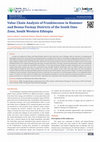
International Journal of Environmental Sciences & Natural Resources, 2017
A study was conducted in Hamer and Benna-Tsemay districts of the South Omo zone of Ethiopia, with... more A study was conducted in Hamer and Benna-Tsemay districts of the South Omo zone of Ethiopia, with the objectives of identifying and mapping the market chain and its functions, providing the picture of supply and use patterns, identifying and suggesting possible intervention of value additive techniques, identifying potential opportunities and constraints in the production, processing and marketing of Frankincense. Twostage sampling strategy used to select Frankincense collectors for the study the producers/collectors and traders within society as well nearby marketing systems were studied through group discussion, personal observation, and using a structured questionnaire where each household was taken as a unit of analysis (45 households from Hammer, 15 from Benna-Tsemay). Simple descriptive statistical tools were used for the analysis. Observation among value chain were summarized using Strength, Weakness, Opportunity and Treat (SWOT) analysis and software called Statistical Package for Social Science (SPSS) were also used for the analysis. Survey results show that almost all of the respondents confirmed that the incense products potentially collected from the natural forest found far away from their villages. Currently the marketing of Frankincense both at Hammer and Benatsemay Woreda of south Omo zone in general is not well developed and there is no established market in place. To advance the value chain the of Frankincense and sustainably contribute to the income of pastoral communities formation of collector groups, associations or cooperatives is needed to foster cooperation and coordination of the collection and marketing of Frankincense.
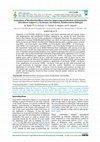
International Journal of Agricultural Research, Innovation and Technology, 2022
Depletion of soil fertility, depletion of macro- and micro-nutrients and soil organic matter and ... more Depletion of soil fertility, depletion of macro- and micro-nutrients and soil organic matter and inappropriate and imbalanced fertilizer application are among the most important factors that reduces the food barley production in Ethiopia. Therefore, the experiment was conducted to evaluate NPSB blended fertilizer rate effect on improving production of food barley in Semen Ari District, Southwestern Ethiopia during main cropping season. Control, (142 NPS + 159 Urea) kg ha-1, (150 NPSB + 41 Urea) kg ha-1, (200 NPSB + 72 Urea) kg ha-1, (250 NPSB + 102 Urea) kg ha-1 and (100 NPSB + 161 Urea) kg ha-1 treatments were used for the experiment which laid out in RCBD following three replication with spacing of 20 cm between rows; and HB 1307 improved food barley seeds were drilled on prepared rows. Full dose of blended and potassium fertilizers were applied at planting time and urea was applied in two split. The result revealed that food barley responded well to application of N, P, S and B t...

A study was conducted in Hamer and Benna-Tsemay districts of the South Omo zone of Ethiopia, with... more A study was conducted in Hamer and Benna-Tsemay districts of the South Omo zone of Ethiopia, with the objectives of identifying and mapping the market chain and its functions, providing the picture of supply and use patterns, identifying and suggesting possible intervention of value additive techniques, identifying potential opportunities and constraints in the production, processing and marketing of Frankincense. Twostage sampling strategy used to select Frankincense collectors for the study the producers/collectors and traders within society as well nearby marketing systems were studied through group discussion, personal observation, and using a structured questionnaire where each household was taken as a unit of analysis (45 households from Hammer, 15 from Benna-Tsemay). Simple descriptive statistical tools were used for the analysis. Observation among value chain were summarized using Strength, Weakness, Opportunity and Treat (SWOT) analysis and software called Statistical Package for Social Science (SPSS) were also used for the analysis. Survey results show that almost all of the respondents confirmed that the incense products potentially collected from the natural forest found far away from their villages. Currently the marketing of Frankincense both at Hammer and Benatsemay Woreda of south Omo zone in general is not well developed and there is no established market in place. To advance the value chain the of Frankincense and sustainably contribute to the income of pastoral communities formation of collector groups, associations or cooperatives is needed to foster cooperation and coordination of the collection and marketing of Frankincense.
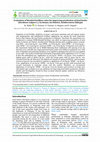
Depletion of soil fertility, depletion of macro-and micro-nutrients and soil organic matter and i... more Depletion of soil fertility, depletion of macro-and micro-nutrients and soil organic matter and inappropriate and imbalanced fertilizer application are among the most important factors that reduces the food barley production in Ethiopia. Therefore, the experiment was conducted to evaluate NPSB blended fertilizer rate effect on improving production of food barley in Semen Ari District, Southwestern Ethiopia during main cropping season. Control, (142 NPS + 159 Urea) kg ha-1 , (150 NPSB + 41 Urea) kg ha-1 , (200 NPSB + 72 Urea) kg ha-1 , (250 NPSB + 102 Urea) kg ha-1 and (100 NPSB + 161 Urea) kg ha-1 treatments were used for the experiment which laid out in RCBD following three replication with spacing of 20 cm between rows; and HB 1307 improved food barley seeds were drilled on prepared rows. Full dose of blended and potassium fertilizers were applied at planting time and urea was applied in two split. The result revealed that food barley responded well to application of N, P, S and B than the unfertilized one. Application of 100 kg ha-1 NPSB + 161 kg ha-1 Urea resulted in highest grain yield of 3806.3 kg ha-1 , while the lowest grain yield of 1939.2 kg ha-1 was recorded from the nil. Moreover, the highest net benefit of 32124.56 ETB ha-1 and economic returns of 942.2% was recorded in response to application of 100 kg ha-1 NPSB + 161 kg ha-1 Urea. Application of 100 kg ha-1 NPSB + 161 kg ha-1 Urea gave 49.05% yield increment and 40.24% increment in economic return over the control. Therefore, we recommend application of 100 kg ha-1 NPSB + 161 kg ha-1 Urea for farmers and investor's in study area and similar agro-ecologies as it was optimum for improving food barley production. Further studies and investigation should be done on plant nutrient uptake, nutrient use efficiency and over location.

A study was conducted to evaluate the early growth performance and nutrient composition of some s... more A study was conducted to evaluate the early growth performance and nutrient composition of some selected tree/shrub species in the fodder bank agroforestry system. Moringa stenopetala, Terminalia brownii, Morus alba, Melia azedarach, and Sesbania sesban were used for this study. Square quadrants of 16 m 2 plot sizes were established with the RCBD of three replications. Seedlings were planted with 1 m × 1 m spacing between rows and plants respectively. The growth and chemical composition of the studied tree/shrub species were evaluated with one way ANOVA. The growth parameters and nutrient composition of the studied fodder tree/shrub species are significantly (P ≤ 0.05) varied. The nutrient composition of the studied tree/shrub species ranged between percentages of 88.3-90.6 of Dry Matter, 5.7-13 of Ash, 12.45-22.35 of Crude Protein, 11.8-23.5 of Acid Detergent Fiber and 18.1-33.6 of Neutral Detergent Fiber. S. sesban and M. stenopetala are the consistent and superior tree/shrub species with growth performance and nutrient content parameters respectively. In addition to this, the selected fodder tree/shrub species are well adapted in the fodder bank agroforestry system and have considerable nutrient constituents. Thus the studied tree species seems to be a potential alternative for complementing the basal feed.

Crop specific fertilizer recommendation is necessary for sustainable crop production. Accordingly... more Crop specific fertilizer recommendation is necessary for sustainable crop production. Accordingly, a field experiment was conducted in Debub Ari district, Southern Ethiopia, to evaluate blended fertilizer types and rates effect on improving the production of wheat during the main rainy season of 2018 and 2019. The experiment was laid out in Randomized Complete Block Design with three replications. The 9 treatments used for the field experiment were 1) control, 2) (142 NPS + 42 urea) kgha-1 , 3) (189 NPS + 72 urea) kgha-1 , 4) (237 NPS +102 urea) kgha-1, 5) (142NPS + 159 urea) kgha-1 , 6) (150NPSB+ 41urea) kgha-1 , 7) (200 NPSB + 72 urea) kgha-1 , 8) (250NPSB + 102Urea) kgha-1 and 9) (150 NPSB + 161Urea) kgha-1 treatments. Application of blended fertilizer significantly (p < 0.05) increased the plant height, number of tillers per plant, spike length, number of seeds per spike, grain yield, aboveground biomass, and thousand seed weight at harvest as compared to the control. The maximum and significant grain yield (3796.7kg ha-1) and minimum (1466.5 kg ha-1) were obtained from the application of 237 kg ha-1 NPS + 102 kgha-1 urea and unfertilized treatment, respectively. The application of 237 kg ha-1 NPS + 102kgha-1 urea had a maximum and acceptable Marginal rate of return (MRR %) and net benefit. Therefore, this type and rate of blended fertilizer can be recommended since it produced a high marginal rate of return, high net benefit, and relatively low total cost of production, for wheat production in the study area and other similar agroecologies.

Journal of Innovative Agriculture
In many developing countries mining plant nutrients by crop removal without adequate replenishmen... more In many developing countries mining plant nutrients by crop removal without adequate replenishment combined with imbalance plant nutrition practices, poses a serious threat to agricultural production. A field experiment was conducted for two consecutive years (2017 to 2018) to observe the response of maize to different rates of NPSB fertilizer. The experiment comprises of five treatments: control (no fertilizer), 150 kg NPSB + 41 kg urea (46N, 54P2O5, 10S, 1.07B), 200kg NPSB + 72kg urea (69N, 72P2O5, 13.5S, 1.4B), 250kg NPSB 102 kg urea (92N, 90P2O5, 17S, 1.75B), and 100kg NPSB + 260kg urea (138N, 36P2O5, 6.7S, 0.71B) were tested using randomized complete block design with three replications. The initial soil physical and chemical analysis indicated that the study area is generally characterized as medium in soil fertility and moderately acidic. The analyzed soil data after harvesting showed that the application of blended fertilizer rates numerically increased the total nitrogen and available sulfur in the soil. However, some nutrients like available P, K, and B become decreased numerically in the soil after harvesting. The result showed that there were significant differences (p<0.05) between treatment. The application of different levels of NPSB fertilizer significantly influenced maize grain yield but there were no significant difference on plant height and biomass yield of maize. 65 to 117% grain yield improvements over control was obtained by application of different rates of NPSB. The highest grain yield of maize was recorded from 100kg NPSB + 260kg urea (138N, 36P2O5, 6.7S, 0.71B) application of the highest net benefit (ET Birr 24226.7) and MRR% (699.1) was also obtained by application of 100kg NPSB + 260kg urea (138N, 36P2O5, 6.7S, 0.71B). It is then recommended that to improve maize yield at Debub Ari and similar agro ecology and soil condition areas application of 100kg NPSB + 260kg urea ha-1 (138N, 36P2O5, 6.7S, 0.71B) is recommended.
公益社団法人日本コンクリート工学会, Jun 3, 1994

A field experiment was conducted on sandy clay soils of Alduba, South omo, south western Ethiopia... more A field experiment was conducted on sandy clay soils of Alduba, South omo, south western Ethiopia for two consecutive years with the aim of determining the optimal fertilizer application rate and the most profitable level for sorghum production. Twenty treatment combinations were made from five levels of nitrogen 0 kg of N ha-1, 23 kg of N ha-1, 46 kg of N ha-1, 69 kg of N ha-1 and 92 kg of N ha-1 with four level of phosphors 0 P kg of ha-1, 10 kg of P ha-1, 20 kg of P ha-1 and 30 kg of Pha-1. The experimental design was a randomized complete block design (RCBD) with three replications. The sorghum improved variety‘ Teshale’ was planted early in Ethiopian ‘Meher’ season of 2014 and 2015 for two years. Based on the objective function of profit maximization to determine the optimum returns, the highest two years average grain yield (2.689 tones ha-1) was recorded at a fertilizer application rate of 46 kg N ha-1 and 30 kg P ha-1 with a gross margin of 19703.27 ETB, net returns of 12991...

A field experiment was conducted on sandy clay soils of Alduba, South omo, south western Ethiopia... more A field experiment was conducted on sandy clay soils of Alduba, South omo, south western Ethiopia for two consecutive years with the aim of determining the optimal fertilizer application rate and the most profitable level for sorghum production. Twenty treatment combinations were made from five levels of nitrogen 0 kg of N ha-1, 23 kg of N ha-1, 46 kg of N ha-1, 69 kg of N ha-1 and 92 kg of N ha-1 with four level of phosphors 0 P kg of ha-1, 10 kg of P ha-1, 20 kg of P ha-1 and 30 kg of Pha-1. The experimental design was a randomized complete block design (RCBD) with three replications. The sorghum improved variety‘ Teshale’ was planted early in Ethiopian ‘Meher’ season of 2014 and 2015 for two years. Based on the objective function of profit maximization to determine the optimum returns, the highest two years average grain yield (2.689 tones ha-1) was recorded at a fertilizer application rate of 46 kg N ha-1 and 30 kg P ha-1 with a gross margin of 19703.27 ETB, net returns of 12991...










Uploads
Papers by shemelis tesema